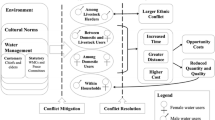Abstract
As domestic water managers, the strategic need of women has been identified as having access to domestic water sources that are convenient, reliable and located close to home. The need has been addressed through installation of low cost improved water supply systems in different parts of the developing world. While the need of women as domestic water managers has been globally articulated and addressed, perhaps adequate attention has not been drawn to the fact that this role is actually performed within the context of local communities where domestic water management activities are built upon the users' perceived needs to be fulfilled through culturally appropriate means. How do cultural intricacies in local communities influence the water fetching behaviour of women? What is the impact of such factors on the adoption and utilization of modern domestic water supply systems? The paper explores the implications of local cultural realities for the effectiveness of handpump as a modern domestic water supply systemarguing that the locally perceived water needs of women are holistic and fail to be adequately addressed through the new source. Consequently, it has been admitted only as an `add on' source, thereby hindering achievement of the basic objective of bringing women greater comfort, better health and socio-economic empowerment.
Similar content being viewed by others
References
Briscoe, J., Chakraborty, M. and Ahmed, S.: 1981, 'How Bengali villagers choose sources of domestic water', Water Supply Management 5, 165-181.
Carr, M. and Sandhu, R.: 1988, Women, Technology and Rural Productivity: An Analysis of Time-and-Energy-Saving Technologies on Women, UNIFEM, New York.
Elmendorf, M. L. and Isely, R. B.: 1983, 'Public and private roles of women in water supply and sanitation programs', Human Organization 42(3), 195-204.
Franceys, R.: 1993, 'Domestic Water Use: Engineering, Effectiveness and Sustainability', in Pro-ceedings of the Conference on 'Priorities for Water Resources Allocation and Management', Natural Resources and Engineering Advisers Conference, Southampton, July 1992,ODA, London.
Kamminga, E.: 1991, Economic Benefits from Improved Rural Water Supply: A Review with a Focus on Women, Occasional Paper Series No. 17, IRC, The Hague.
McClure, G.: 1989, 'Introduction', in D. Michael Warren, I. Jan Sikkerveer and S. Titilola (eds), Indigenous Knowledge Systems: Implications for Agriculture and International Development, Technology and Social Change Program, Ames, NRC.
Ministry of Rural Development: 2002, Annual Report 2001-2002, Ministry of Rural Development, Government of India, New Delhi.
Mukherjee, N.: 1990, People, Water and Sanitation: What They Know, Believe and Do in Rural India, The National Drinking Water Mission, New Delhi.
Nichter, M.: 1996, 'Drink Boiled Cooled Water: A Cultural Analysis of a Health Education Message, in Mark Nichter and Mimi Nichter', Anthropology and International Health: Asian Case Studies, Gordon and Breach Publishers, The Netherlands.
Rajiv Gandhi National Drinking Water Mission (RGNDWM): 2000, Guidelines for Implementa-tion of Rural Water Supply Program, Department of Drinking Water Supply, Ministry of Rural Development, Government of India, New Delhi.
Reynolds, J.: 1992, Handpumps: Toward a Sustainable Technology, UNDP-World Bank Water and Sanitation Program, Washington.
UNICEF Evaluation Office: 2002, Learning from Experience: Water and Sanitation in India, UNICEF, New York.
Van Wijk-Sijbesma, C.: 1985, 'Participation of Women in Water Supply and Sanitation-Roles and Realities', Technical Paper 22, IRC, The Hague.
Van Wijk, C.: 1992, 'State of the art review: Drinking water supply and sanitation projects: Impacts on women', Annual Abstr. J. 2, IRC.
Wellin, E.: 1955, 'Water Boiling in a Peruvian Town', in F. Hinchcliff, J. Thompson, J. Pretty, I. Guijt and P. Shah (eds), Health, Culture and Community, IT Publications, London.
White, G. F., Bradley, D. J. and White, A. U.: 1972, Drawers of Water: Domestic Water Use in East Africa, University of Chicago Press, Chicago.
World Water Council: 2003, The Third World Water Forum: Final Report, Secretariat of the Third World Water Forum, Tokyo.
Author information
Authors and Affiliations
Corresponding author
Rights and permissions
About this article
Cite this article
Singh, N., Bhattacharya, P., Jacks, G. et al. Women and Modern Domestic Water Supply Systems: Need for a Holistic Perspective. Water Resources Management 18, 237–248 (2004). https://doi.org/10.1023/B:WARM.0000043164.43638.68
Issue Date:
DOI: https://doi.org/10.1023/B:WARM.0000043164.43638.68




